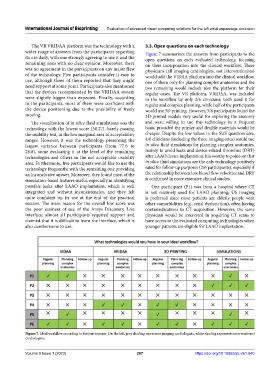Page 275 - IJB-9-1
P. 275
International Journal of Bioprinting Evaluation of advanced visual computing solutions for the left atrial appendage occlusion
The VR VRIDAA platform was the technology with a 3.3. Open questions on each technology
wider range of answers from the participants regarding Figure 7 summarizes the answers from participants to the
its use daily, with one strongly agreeing to use it and the open questions on each evaluated technology, focusing
remaining ones with no clear opinion. Moreover, there on their incorporation into the clinical workflow. Three
was no agreement in the participants on any major flaw physicians (all imaging cardiologists, not interventionists)
of the technology. Five participants consider it easy to would add the VIDAA platform into the clinical workflow,
use, although three of them reported that they might one of them only for planning complex anatomies and the
need support at some point. Participants also mentioned two remaining would include also the platform for their
that the devices recommended by the VRIDAA system regular cases. The VR platform, VRIDAA, was included
were slightly bigger than expected. Finally, according in the workflow by only 2/6 clinicians; both used it for
to the participants, most of them were confident with regular and complex planning, while half of the participants
the device positioning due to the possibility of freely would use 3D printing. However, 5/6 participants found the
moving. 3D-printed models very useful for exploring the anatomy
The visualization of in silico fluid simulations was the and were willing to use this technology in a frequent
technology with the lowest score (58.27), barely passing basis, provided the printer and flexible materials would be
the usability test, in the low marginal area of acceptability cheaper. Despite the low values in the SUS questionnaire,
ranges. However, it was the technology presenting the 4/6 clinicians (including the three imaging ones) would use
largest variance between participants (from 77.6 to in silico fluid simulations for planning complex anatomies,
28.8), some evaluating it at the level of the remaining mainly to avoid leaks and device-related thrombus (DRT)
technologies and others in the not acceptable usability after LAAO device implantation. It is worthy to point out that
area. Furthermore, five participants would like to use the in silico fluid simulations are the only technology positively
technology frequently, with the remaining one providing rated for follow-up purposes (2/6 participants), especially if
an inconclusive answer. Moreover, they found most of the the relationship between low blood flow velocities and DRT
simulation-based features useful, especially in identifying is confirmed in more extensive clinical studies.
possible leaks after LAAO implantation, which is well One participant (P1) was from a hospital where CT
integrated and without inconsistencies, and they felt is not routinely used for LAAO planning; US imaging
quite confident on its use at the end of the practical is preferred since most patients are elderly people with
session. The main reason for the overall low score was other comorbidities (e.g., renal dysfunction), often having
the poor easiness of use of the Ansys Discovery Live contraindications to CT acquisition. However, the same
interface; almost all participants required support and physician would be interested in acquiring CT scans to
claimed that it is difficult to learn the interface, which is have access to the evaluated computing technologies when
also cumbersome to use. younger patients are eligible for LAAO implantation.
Figure 7. Ideal workflow according to the participants. On the left, gray shading represents imaging cardiologists, white shading represents interventional
cardiologists.
Volume 9 Issue 1 (2023) 267 https://doi.org/10.18063/ijb.v9i1.640

